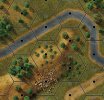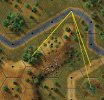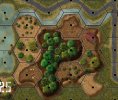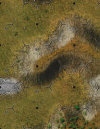Stefano G.
Member
Hello everyone and sorry if my question was already dealt.
We know that in LnLT maps, terrain silhouettes are considered when tracing LOS: so, if a LOS intersects a Light Wood Hex (degrading) BUT does not pass through any silhouettes of Light Wood, the LOS is considered clear (not degraded by crossed LW hex).
In many maps, Hill countour/silhouette is not well defined: it is soft, pale (see image1) ,and graphically very nice to be seen BUT it's very hard to check if a LOS touches/crosses it.
For example, in image1LOS, are the 3 yellow LOS blocked by 1-level Hill Hexes?
1) D5 - F3: D5 is 1-level Forest-Hill Hex and, according to new V.5.0 Rules, can see 0-level F3 because only E3 hex is shadowed by E4.
2) G6 - F3 : are 0-level Hexes both of them. Not having a well defined Hill countour/silhouette (F4) it's hard to see if LOS is blocked or not...surely it's degraded by tree of Light Wood, but is it blocked too?...how to decide?
3) G5 - F3: same as above...but uncertainty is now greater.
At the opposite, in HoD Maps, Hills countours/silhouettes are well defined with a clear line and there is no problem in checking if LOS touches or crosses them. (see image2)
Can you help me?
Thank you
Image1-HotM
image1LOS-HotM
image2-HoD

We know that in LnLT maps, terrain silhouettes are considered when tracing LOS: so, if a LOS intersects a Light Wood Hex (degrading) BUT does not pass through any silhouettes of Light Wood, the LOS is considered clear (not degraded by crossed LW hex).
In many maps, Hill countour/silhouette is not well defined: it is soft, pale (see image1) ,and graphically very nice to be seen BUT it's very hard to check if a LOS touches/crosses it.
For example, in image1LOS, are the 3 yellow LOS blocked by 1-level Hill Hexes?
1) D5 - F3: D5 is 1-level Forest-Hill Hex and, according to new V.5.0 Rules, can see 0-level F3 because only E3 hex is shadowed by E4.
2) G6 - F3 : are 0-level Hexes both of them. Not having a well defined Hill countour/silhouette (F4) it's hard to see if LOS is blocked or not...surely it's degraded by tree of Light Wood, but is it blocked too?...how to decide?
3) G5 - F3: same as above...but uncertainty is now greater.
At the opposite, in HoD Maps, Hills countours/silhouettes are well defined with a clear line and there is no problem in checking if LOS touches or crosses them. (see image2)
Can you help me?
Thank you
Image1-HotM

image1LOS-HotM

image2-HoD

Last edited:
